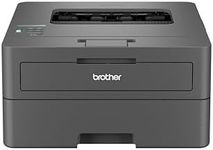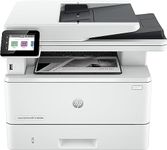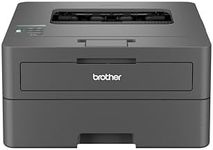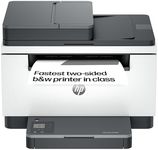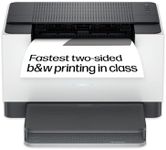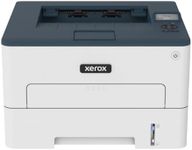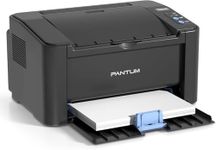Buying Guide for the Best Black And White Printers
When choosing a black-and-white printer, it's important to consider your specific needs and how the printer will be used. Whether you're looking for a printer for home use, a small office, or a large business, understanding the key specifications will help you make an informed decision. Here are some important specs to consider and how to navigate them.Print SpeedPrint speed is measured in pages per minute (PPM) and indicates how quickly a printer can produce documents. This spec is important because it affects productivity, especially in environments where large volumes of printing are required. For home use or small offices, a print speed of 20-30 PPM is usually sufficient. For larger offices or businesses with high printing demands, look for printers with speeds of 40 PPM or higher. Consider your typical printing volume to determine the right print speed for you.
Print QualityPrint quality is measured in dots per inch (DPI) and determines the clarity and detail of the printed documents. Higher DPI values result in sharper and more detailed prints. For most text documents, a DPI of 600x600 is adequate. If you need to print detailed graphics or images, consider a printer with a higher DPI, such as 1200x1200. Think about the type of documents you will be printing most often to choose the appropriate print quality.
Duty CycleThe duty cycle is the maximum number of pages a printer can handle in a month without experiencing issues. This spec is crucial for ensuring the printer can meet your printing demands. For home use, a duty cycle of up to 5,000 pages per month is usually enough. Small to medium-sized offices might need a duty cycle of 10,000 to 20,000 pages, while large businesses should look for printers with a duty cycle of 50,000 pages or more. Assess your monthly printing volume to select a printer with an appropriate duty cycle.
Connectivity OptionsConnectivity options determine how you can connect to and use the printer. Common options include USB, Ethernet, and Wi-Fi. USB is suitable for direct connections to a single computer, while Ethernet is ideal for networked environments where multiple users need access. Wi-Fi allows for wireless printing from various devices, including smartphones and tablets. Consider your setup and how you prefer to print when choosing connectivity options. For flexibility, a printer with multiple connectivity options is often the best choice.
Paper HandlingPaper handling refers to the types and sizes of paper a printer can accommodate, as well as the capacity of its paper trays. This spec is important for ensuring the printer can handle your specific printing needs. For general use, a printer with a standard paper tray capacity of 250 sheets and the ability to handle various paper sizes (e.g., letter, legal) is usually sufficient. If you frequently print large documents or use different paper types, look for printers with higher capacity trays and additional features like automatic duplexing (double-sided printing). Match the paper handling capabilities to your typical printing tasks.
Cost of ConsumablesThe cost of consumables includes the price of toner cartridges and other replaceable parts. This spec is important because it affects the overall cost of ownership. Some printers have lower upfront costs but higher ongoing expenses due to expensive consumables. To manage costs, look for printers with affordable and high-yield toner cartridges, which can print more pages before needing replacement. Consider the long-term costs and availability of consumables when choosing a printer.
